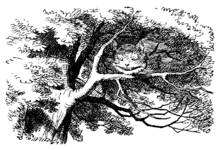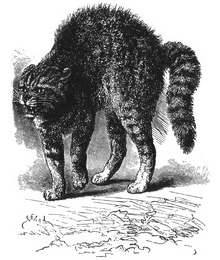Expressive behavior
Expressive behavior is a technical term in behavioral biology . It describes all behavioral patterns "that have the character of a trigger and serve the intraspecial (occasionally also the interspecial) communication." Synonyms for this are emotional movements (as with Georg Ernst Stahl ) or display (younger term).
These behavior patterns have either emerged in the phylogenetic process of intra-species communication through body language or have emerged from dealing with other, competing species . As social signals, they indicate the mood of an animal and thus influence the behavior of individuals of the same or a different species. The expressive behavior is therefore also suitable for determining the emotional state of pets depending on the situation .
Forms of expressive behavior
Expressive behavior includes both visual signals ( expressive movements ) and acoustic signals ( e.g. warning signals ), as well as touch and elements of olfactory communication . Widely known is the peacock's tail feathers turning into a "wheel" , but also the singing of the nightingale , the simulation of a broken wing in the presence of a predator (whereupon it pursues the apparently sick bird and not its young), the mating replay , the dance language of the Bees and the undulating, rising and then falling flight of the male golden eagle can be interpreted as expressive behavior.

The "purpose" of expressive behavior can be, for example:
- soliciting a partner
- the intimidation of rivals
- claiming a territory
- the initiation of copulation
- deterring an attacker
- communicating danger to group members
- luring an attacker away from the boys.
See also
- emotion
- Gesture of humility
- Display behavior
- Threatening behavior
- Appeasement signal (dog)
- Handicap principle
- Nonverbal communication
literature
- Charles Darwin : The Expression of Emotions in Man and Animals . Eichborn 2000. ISBN 3821841885 (Critical edition of the original 1872 edition by Paul Ekman )
- Nikolaas Tinbergen : On the sociology of the herring gull , Larus a. argentatus Pont. In: "Contributions to the reproductive biology of birds", Volume 12, 1936, pp. 89-96
- Konrad Lorenz : Here I am - where are you? Ethology of the greylag goose. Munich, Zurich: Piper, 1988
- Dorit Urd Feddersen-Petersen : Expressive behavior in dogs. Facial expressions, body language, communication and understanding . Franckh-Kosmos Verlag 2008. ISBN 344009863X
Web links
- rudelberater.de ( Memento from February 19, 2009 in the Internet Archive ) Examples of expressive behavior in dingoes (PDF; 871 kB)
- uni-saarland.de ( Memento from February 27, 2009 in the Internet Archive ) Information on a lecture on emotions and expressive behavior
- sueddeutsche.de Joachim Marschall: "Mienenspiel: Fear sharpens the senses." Süddeutsche Zeitung of June 17, 2008, p. 16
Individual evidence
- ^ Keyword expressive behavior in: Klaus Immelmann : Grzimeks Tierleben , supplementary volume behavior research. Kindler Verlag, Zurich 1974, p. 622.
- ↑ Bernward Josef Gottlieb (Ed.): Georg Ernst Stahl: About the manifold influence of emotional movements on the human body (Hall 1695) / About the importance of the synergic principle for medicine (Hall 1695) / About the difference between organism and mechanism ( Hall 1714) / Considerations for a doctor's home visit (Hall 1703). Leipzig 1961 (= Sudhoff's classics of medicine. Volume 36.).
- ↑ Expressive behavior for assessing sensitivities in horses. On: vetline.de , summary of a study from Dtsch.tierärztl.Wschr. Volume 114, No. 3, 2007, pp. 91-97.
- ↑ Konrad Lorenz : Comparative behavior research. Basics of ethology. Springer-Verlag, Vienna and New York 1978, p. 195, ISBN 978-3-7091-3098-8 .
- ↑ Golden Eagle, Aquila chrysaetos. ( Memento from January 2, 2010 in the Internet Archive )
